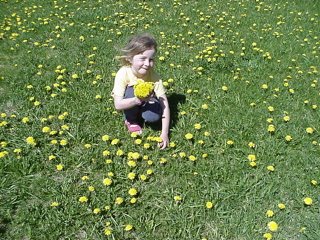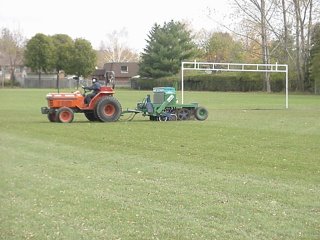
Weedy Options
What a fine crop of dandelions this year. Nothing like a little heat, followed by a lot of rain, to bring out the carpet of yellow. There are conflicting opinions on dandelions in turf. On fine turf areas like sports fields and golf courses they can affect play as well as sports field safety if present in great numbers. On lawns, their value is more debatable. One man's weed is a child's bouquet for mother's day. My personal peeve with dandelions is not as much their presence in the lawn, but the fact that they seed freely and inevitably each year I have to dig them out of one of my perennial gardens or gouge one out of the patio or rockery.
In general, the presence of dandelions and other broadleaf weeds indicates thin turf. On my own home lawn, which I cut at different heights for recreational purposes, dandelions and other weeds are only a problem on the shorter cut lawn areas. On the sections of the lawn I cut as high as my mower goes and return the clippings, there are very few dandelions present. If you have a relatively dandelion-free lawn to start, you can keep them to a minimum by mowing high, returning the clippings to the lawn (preferably by using a mulching mower) as well as fertilizing to keep the grass thick and healthy.
What are the options for getting rid of dandelions? The easiest is a three-way herbicide application when the dandelions are actively growing. The simplest and safest approach is to hire a licenced professional lawn care operator to treat your lawn. Hiring a lawn care company that is IPM certified (in Ontario) will insure that only the bare minimum of chemical is used. If you insist on doing it yourself, a premixed spray kit or hose end attachment will insure you apply the proper rate. READ THE LABEL to insure you follow all appropriate precautions. Granular "weed and feed" formulations are convenient but do not allow you to spot treat your lawn and are only recommended in situations where you have a heavy weed infestation across the entire lawn. In all situations, keep kids and pets off the lawn for 24 hours and exposure should be nil. If you are concerned about herbicide use and safety, check out Questions and Answers about 2,4-D from Health Canada's Pest Management Regulatory Agency.
The only alternative to chemical treatment is to hand dig the dandelions. A number of tools are available for this job but you want something that will remove the entire plant, tap root and all. I am trying to acquire as many of these tools as possible to evaluate them for efficacy and ease of use. If you have a favourite dandelion digging tool, please let me know.
Crabgrass is another lawn weed that will soon be rearing it's unsightly head. Crabgrass is an annual grass that also invades thin, short cut turf. The number one defence is mowing high and keeping your lawn thick and healthy. There are a number of herbicide options for crabgrass control including the natural product corn gluten meal. Corn gluten meal is a component of many pet foods. Researchers were using corn gluten meal as a carrier for a fungus they using to infect turf research plots and accidentally discovered that the corn gluten meal suppressed the growth of annual weeds. It needs to be applied quite heavily and early in the season prior to or as the crabgrass is germinating. It is now being carried by many garden centres in a special formulation for lawn use. Follow the label instructions regarding application rates. It is important to note that the use of corn gluten meal or chemical herbicides that prevent weed seed germination are incompatible with an overseeding program to thicken or repair your lawn. They do not distinguish between the good seeds and the bad seeds when it comes to suppressing germination.
Feeding Your Lawn
"Feeding plants" is a bit of a misnomer as plants do not really eat. They take nutrients and water from the soil, carbon dioxide from the air and capture energy from the sun through photosynthesis transforming the carbon into the more complex and energy rich sugar molecules upon which all life on this planet depends.
The general recommendation for a moderately maintained Kentucky bluegrass lawn is to fertilize your lawn 3-4 times per season. From now until early June is an excellent time to make your first application of the season. A slow release formulation will insure that nutrients are released at a rate compatible with plant needs. Unlike flower gardens, in lawns we want vegetative, leafy growth so a fertilizer with a high nitrogen content is used. A recommended ratio of 4-1-2 like 20-5-10 or thereabouts is optimal for turf use. What do these numbers mean?
20-5-10
the fertilizer contains
20% Nitrogen -5% Phosphorus - 10% Potassium
Organic fertilizers have a natural slow release pattern but are typically lower in nutrients and cost more per pound or kilogram of nutrient. Lawns are prolific producers of organic material in the form of leaves and roots and there is no scientific evidence that shows organic fertilizers provide any additional value to your lawn. However, they typically have less burn potential in the event of an accidental spill or excessive application and they are a way of recycling organic wastes. Whether the granulating, bagging and transportation of organic based fertilizers is environmentally efficient or just a way of "adding value" to a waste product that would otherwise cost the producer to dispose is a question for another day.
The goal is to apply 0.5 kg of nitrogen per 100 square meters or about a pound of nitrogen per 1,000 square feet. Generally you can follow the instructions on the bag but if you have trouble figuring out what setting to use on your spreader, here is how you do it. Mathphobics can skip this section but should invest in a spreader that has settings compatible with the brand of fertilizer you use.
Measure the area of your lawn. It is easier to divide your lawn into logical areas such as front. back and side. Calculate how much fertilizer you need to apply 0.5 kg of nitrogen per 100 square meters. For example, a 24-6-12 fertilizer would require approximately 2 kg of fertilizer per 100 square meters calculated as follows:
24% = .24 and x = amount of fertilizer needed
.24 x = o.5
x = 0.5/.24
x = 2.08
Now figure out how much fertilizer you need in total to apply to your lawn area. For example, if your lawn was 250 square meters, you would need 2.5 X 2 = 5 kg of fertilizer. Weight out the amount you need using a pail on your bathroom scale. Set your spreader so the opening is just wider then the largest fertilizer granule. Place the required amount of fertilizer in the spreader and commence application using a crisscross pattern. Once you have covered the area, repeat with a pattern that is at right angles to the first. Continue until you have applied the required amount of fertilizer to the area.
Avoid getting any fertilizer granules onto driveways, roads or other hard surfaces. Sweep any excess back onto the lawn. Always fill your spreader on a hard surface as spillage on your lawn is difficult to sweep up and can burn the turf.
the fertilizer contains
20% Nitrogen -5% Phosphorus - 10% Potassium
Organic fertilizers have a natural slow release pattern but are typically lower in nutrients and cost more per pound or kilogram of nutrient. Lawns are prolific producers of organic material in the form of leaves and roots and there is no scientific evidence that shows organic fertilizers provide any additional value to your lawn. However, they typically have less burn potential in the event of an accidental spill or excessive application and they are a way of recycling organic wastes. Whether the granulating, bagging and transportation of organic based fertilizers is environmentally efficient or just a way of "adding value" to a waste product that would otherwise cost the producer to dispose is a question for another day.
The goal is to apply 0.5 kg of nitrogen per 100 square meters or about a pound of nitrogen per 1,000 square feet. Generally you can follow the instructions on the bag but if you have trouble figuring out what setting to use on your spreader, here is how you do it. Mathphobics can skip this section but should invest in a spreader that has settings compatible with the brand of fertilizer you use.
Measure the area of your lawn. It is easier to divide your lawn into logical areas such as front. back and side. Calculate how much fertilizer you need to apply 0.5 kg of nitrogen per 100 square meters. For example, a 24-6-12 fertilizer would require approximately 2 kg of fertilizer per 100 square meters calculated as follows:
24% = .24 and x = amount of fertilizer needed
.24 x = o.5
x = 0.5/.24
x = 2.08
Now figure out how much fertilizer you need in total to apply to your lawn area. For example, if your lawn was 250 square meters, you would need 2.5 X 2 = 5 kg of fertilizer. Weight out the amount you need using a pail on your bathroom scale. Set your spreader so the opening is just wider then the largest fertilizer granule. Place the required amount of fertilizer in the spreader and commence application using a crisscross pattern. Once you have covered the area, repeat with a pattern that is at right angles to the first. Continue until you have applied the required amount of fertilizer to the area.
Avoid getting any fertilizer granules onto driveways, roads or other hard surfaces. Sweep any excess back onto the lawn. Always fill your spreader on a hard surface as spillage on your lawn is difficult to sweep up and can burn the turf.

